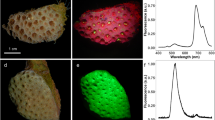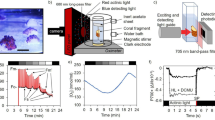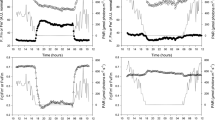Abstract.
Chlorophyll-a fluorescence was measured in six species of coral, using pulse-amplitude-modulated fluorometers employing fibre-optic probes with diameters of 8 mm, 1 mm and 140 µm. The 8-mm probe integrated responses over a large area, giving more weight to coenosarc than polyp tissue for Acropora nobilis. With 1-mm and 140-µm fibre-optic probes, the photosynthetic responses of zooxanthellae in the coenosarc and the polyp tissue of Acropora nobilis were distinguished. The polyp tissue exhibited a lower maximum in relative electron transport rate than did the coenosarc tissue, and was subject to down-regulation at higher irradiances. Coenosarc and polyp tissue (both containing zooxanthellae) showed a wide range of responses in the other corals. Down-regulation of photosynthesis in a single polyp of Pocillopora damicornis was followed after exposure to moderate irradiance, with recovery occurring over a further 4 h of shade conditions. All the corals (Acropora millepora, A. nobilis, Cyphastrea serailia, Montipora tuberculosa, Pocillopora damicornis and Porites cylindrica) showed evidence of strong down-regulation of photosynthesis under high irradiance, and little evidence of photoinhibitory damage to photosystem II.
Similar content being viewed by others
Explore related subjects
Discover the latest articles and news from researchers in related subjects, suggested using machine learning.Author information
Authors and Affiliations
Additional information
Electronic Publication
Rights and permissions
About this article
Cite this article
Ralph, .P., Gademann, .R., Larkum, .A. et al. Spatial heterogeneity in active chlorophyll fluorescence and PSII activity of coral tissues. Marine Biology 141, 639–646 (2002). https://doi.org/10.1007/s00227-002-0866-x
Received:
Accepted:
Issue Date:
DOI: https://doi.org/10.1007/s00227-002-0866-x




